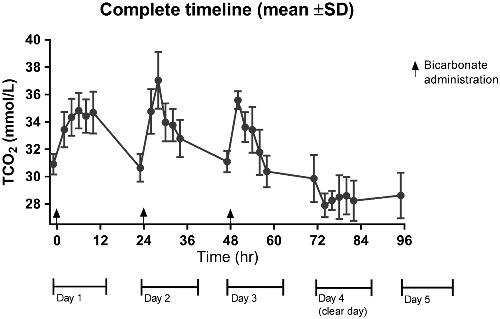当前位置:
X-MOL 学术
›
Drug Test. Anal.
›
论文详情
Our official English website, www.x-mol.net, welcomes your
feedback! (Note: you will need to create a separate account there.)
The effect of serial administration of bicarbonate on plasma total CO2 concentrations in horses
Drug Testing and Analysis ( IF 2.6 ) Pub Date : 2020-11-08 , DOI: 10.1002/dta.2937 Simon R Bailey 1 , Grace Forbes 2 , Naomi Selvadurai 3 , Katelin McLarney 1 , Susan Jones 1 , Catherine M Steel 1, 4
Drug Testing and Analysis ( IF 2.6 ) Pub Date : 2020-11-08 , DOI: 10.1002/dta.2937 Simon R Bailey 1 , Grace Forbes 2 , Naomi Selvadurai 3 , Katelin McLarney 1 , Susan Jones 1 , Catherine M Steel 1, 4
Affiliation

|
The administration of alkalinising agents including bicarbonate is of concern to racing authorities because resultant alkalosis may enhance performance and interfere with the detection of drugs in post‐race urine. A threshold for total carbon dioxide (TCO2) of 36.0 mmol/L in plasma (with action limit of 37.0 mmol/L) has been set. Serial dosing of sodium bicarbonate has gained popularity in human athletes but has not been studied in horses previously. Sodium bicarbonate (200 g per horse) and 60 g of an electrolyte‐vitamin complex was administered in 2‐L water via nasogastric intubation to five Standardbred horses for three consecutive days (total dose bicarbonate 0.42 ± 0.02 g/kg). Serial blood samples were taken over Days 1–5, with the final day (5) intended to simulate a ‘clear day’, and TCO2 was analysed. Following the first bicarbonate administration, plasma TCO2 peaked at 6 h (34.8 ± 1.3 mmol/L), returning to baseline by 23 h. On Day 2, four out of the five horses showed a peak greater than 36.0 mmol/L (mean 37.0 ± 2.1 mmol/L). With daily repeated dosing, plasma TCO2 peaked progressively earlier, and by Day 3, the peak occurred at 2 h and concentrations declined more rapidly. On Days 4 and 5, TCO2 levels remained low (<32.1 mmol/L on Day 4 and between 27.0–31.2 mmol/L on Day 5). These studies demonstrate that serial dosing of a ‘split dose’ of sodium bicarbonate on three consecutive days does not result in the accumulation or carry‐over of plasma TCO2 levels beyond the levels observed following a single dose.
中文翻译:

连续给予碳酸氢盐对马血浆总二氧化碳浓度的影响
包括碳酸氢盐在内的碱化剂的使用引起了赛车当局的关注,因为由此产生的碱中毒可能会提高性能并干扰赛后尿液中药物的检测。血浆中总二氧化碳 (TCO 2 ) 的阈值为36.0 mmol/L(作用极限为 37.0 mmol/L)。连续服用碳酸氢钠在人类运动员中很受欢迎,但之前尚未在马身上进行过研究。碳酸氢钠(每匹马 200 克)和 60 克电解质-维生素复合物在 2 升水中通过鼻胃管插管连续三天给五匹 Standardbred 马给药(碳酸氢钠的总剂量为 0.42 ± 0.02 g/kg)。在第 1-5 天采集连续血样,最后一天 (5) 旨在模拟“晴天”,TCO 2进行了分析。第一次碳酸氢盐给药后,血浆 TCO 2在 6 小时达到峰值 (34.8 ± 1.3 mmol/L),23 小时后恢复到基线水平。在第 2 天,五匹马中有四匹表现出大于 36.0 mmol/L(平均 37.0 ± 2.1 mmol/L)的峰值。随着每天重复给药,血浆 TCO 2逐渐达到峰值,到第 3 天,峰值出现在 2 小时,并且浓度下降得更快。在第 4 天和第 5 天,TCO 2水平仍然很低(第 4 天 <32.1 mmol/L,第 5 天在 27.0-31.2 mmol/L 之间)。这些研究表明,连续三天连续给药“分剂量”碳酸氢钠不会导致血浆 TCO 2水平的积累或残留超过单次给药后观察到的水平。
更新日期:2020-11-08
中文翻译:

连续给予碳酸氢盐对马血浆总二氧化碳浓度的影响
包括碳酸氢盐在内的碱化剂的使用引起了赛车当局的关注,因为由此产生的碱中毒可能会提高性能并干扰赛后尿液中药物的检测。血浆中总二氧化碳 (TCO 2 ) 的阈值为36.0 mmol/L(作用极限为 37.0 mmol/L)。连续服用碳酸氢钠在人类运动员中很受欢迎,但之前尚未在马身上进行过研究。碳酸氢钠(每匹马 200 克)和 60 克电解质-维生素复合物在 2 升水中通过鼻胃管插管连续三天给五匹 Standardbred 马给药(碳酸氢钠的总剂量为 0.42 ± 0.02 g/kg)。在第 1-5 天采集连续血样,最后一天 (5) 旨在模拟“晴天”,TCO 2进行了分析。第一次碳酸氢盐给药后,血浆 TCO 2在 6 小时达到峰值 (34.8 ± 1.3 mmol/L),23 小时后恢复到基线水平。在第 2 天,五匹马中有四匹表现出大于 36.0 mmol/L(平均 37.0 ± 2.1 mmol/L)的峰值。随着每天重复给药,血浆 TCO 2逐渐达到峰值,到第 3 天,峰值出现在 2 小时,并且浓度下降得更快。在第 4 天和第 5 天,TCO 2水平仍然很低(第 4 天 <32.1 mmol/L,第 5 天在 27.0-31.2 mmol/L 之间)。这些研究表明,连续三天连续给药“分剂量”碳酸氢钠不会导致血浆 TCO 2水平的积累或残留超过单次给药后观察到的水平。











































 京公网安备 11010802027423号
京公网安备 11010802027423号